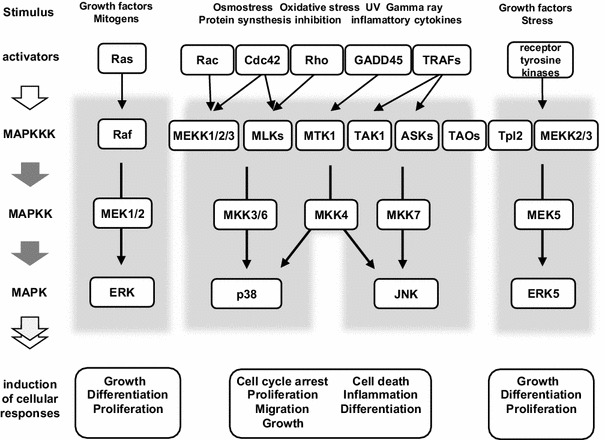Fig. 1.

Schematic diagrams of conventional MAPK signaling cascades. Mammalian cells simultaneously express several subfamilies of MAPK cascades. They include the growth-promoting extracellular-signal regulated kinase (ERK) family and the growth-suppressing stress-activated protein kinase (SAPK) families, the JNK and p38, and the relatively recently discovered ERK5. The ERK family cascade consists of a three-tired kinase cascade of a MAP3K (Raf), MAP2K (MEK) and MAPK (ERK). Activation of a small-G protein Ras triggers the activation of Raf and thus begins the cascade. Similarly, a wide variety of stresses activates the SAPK cascades via diverse stress MAP3Ks and their activators. Although there are at least 14 stress MAP3Ks, many fewer MAP2Ks (MKK3/4/6/7) and MAPKs (p38α/ß/γ/δ and JNK1/2/3) function in the stress response pathway. The activators of stress MAP3Ks include the small-G proteins (Rac, Rho and Cdc42), TRAFs and GADD45s. The MEK5-ERK5 pathway is also activated by several types of stresses and growth factors and shares some stress MAP3Ks (MEKK2/3) with JNK and p38. Arrows indicate the activation signal. Abbreviations used in this figure are as follows: MEK MAPK/ERK kinase, MEKK MEK kinase, MLK mixed-lineage kinase, TAK1 transforming growth factor ß-activated kinase, MTK1 MAP three kinase 1, ASK apoptosis signal-regulating kinase, TAO thousand and one amino-acid kinase, Tpl tumor progression locus, TRAF tumor necrosis factor receptor-associated factor, GADD growth arrest and DNA damage-inducible protein
